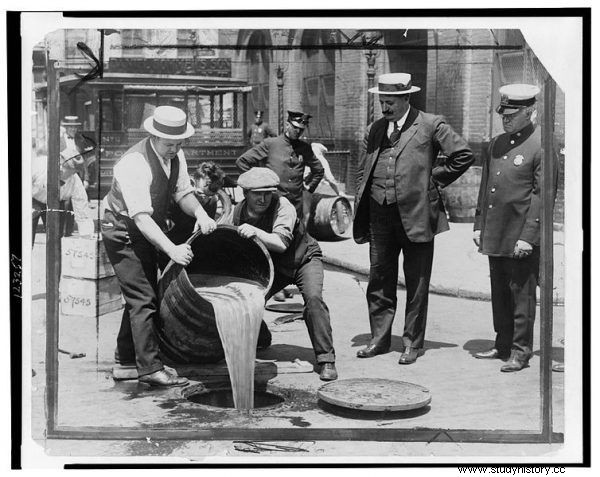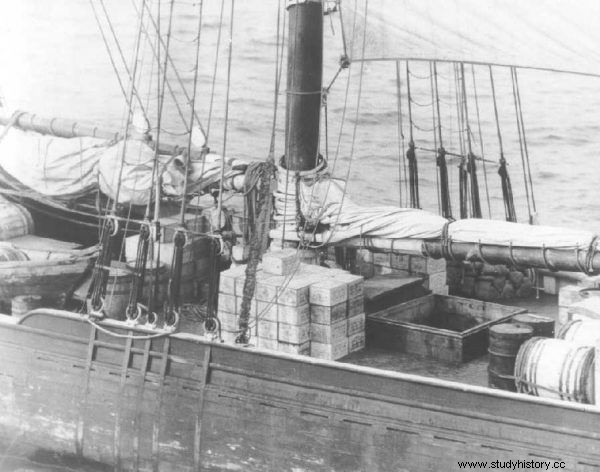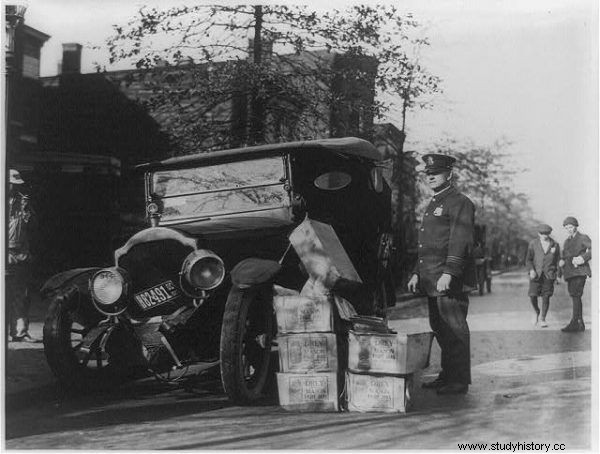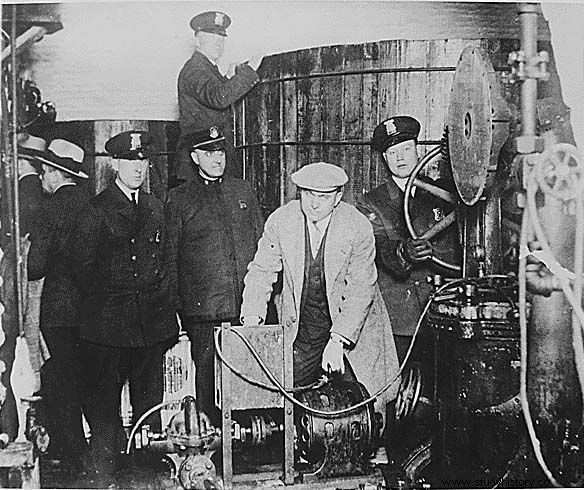Illicit alcohol consumption during Prohibition was the main pastime of New Yorkers. In fact, refraining from drinking alcoholic beverages was an expression of inappropriate behavior at social and business meetings. Americans made the driving, distribution and consumption of illegal alcohol almost a national sport.
After the 18th Amendment to the US Constitution was passed and ratified, it was immediately known that full control over prohibition seemed downright impossible. Americans considered drinking drinks a lot of fun and didn't care about the law.
Prohibition - a perverse incentive to reach for a glass
Many residents of New York and other large cities, previously avoiding alcohol, began to drink alcohol in such quantities that ... fell into alcoholism. One of the most interesting was the story of Robert Benchley, a popular cartoonist and passionate supporter of prohibition. During one of the forays with his fellow writer, Dorothy Parker wanted to find out what all the hype was about and try whiskey with ice. He liked Scottish so much that at the end of the 1920s he became addicted to alcohol and the cause of his death was complications from hepatitis!

Pouring alcohol from the barrel during Prohibition
1. Prescription whiskey
Distilleries that produced whiskey for medicinal purposes were allowed to legally produce whiskey. Manufacturers of alcohol-containing drugs were free to continue working during the Prohibition era, doctors were allowed to prescribe whiskey and patients were allowed to bring "the medicine" home. By 1933, doctors had managed to prescribe as many as 6 million times a high-percentage drug ...
2. It was worth becoming a Judaist
An effective method of guaranteeing permanent access to alcohol was to adopt the Jewish religion, because Jewish families were provided with a monthly allocation of wine on the basis of the certificate received from the rabbi. Just one year after the introduction of Prohibition, there was a tenfold increase in the number of Jewish families and an even greater increase in rabbis, including black and Italian rabbis, who can issue certificates.
3. Bootlegging
Bootlegging, or alcohol smuggling, flourished during Prohibition. On ships, rum, whiskey and gin were transported among legal goods. Full wagons of whiskey were transported by trains under the cover of completely different products. According to data from the treasury department, only 5% of illegal alcohol is seized by its agents, and many policemen were involved in the whole smuggling process. In 1924 alone, bootlegging in America was estimated at $ 40 million.

Bootlegging - illegal alcohol transported by ship
4. Malt extract
Despite the ban, many breweries sold beer illegally. As you know, necessity is the mother of invention, so the brewing tycoons were able to cope with these difficult times. Instead of selling the finished product, they came up with the idea of offering malt extract, and everyone could easily process the malt into beer, hence many homes produced this golden drink.
5. Industrial alcohol treatment
One gallon of spirit yielded three gallons of diluted and colored liquor sold as Scotch whiskey "straight from the boat". In the 1920s, 15 million gallons a year of high-grade industrial fluids were processed into counterfeit drinking alcohol. In the next decade, the authorities tried to take steps to eliminate this source of illegal alcohol, but the head of the Prohibition Bureau himself noted that this criminal practice was in full swing.
6. Distillery
Shady distilleries were the central point of the production of low-key liquors. As much as eight times more illegal alcohol was produced in these places than was obtained from industrial alcohol. Corn sugar was indispensable for the production of alcohol. During the decade, between 1919 and 1929, there was a six-fold increase in the demand for this sugar, and it is worth knowing that this product had few legal uses. The corn sugar was mainly obtained from bourbon, the so-called corn whiskey.
In those days, you had to be careful about the source of counterfeit alcoholic beverages, as poisoning, paralysis or blindness could occur after consuming poisonous alcohol. Consumers of Jamaica Ginger suffered from a disease called Jake Leg, there was damage to the nervous system and muscles, which resulted in limited or complete loss of free movement of the arms and legs.

A policeman guarding confiscated moonshine, referred to by Americans as moonshine or mountain dew
7. Home distilleries
The families themselves produced alcohol:beer, wine or stronger alcoholic beverages. The homegrown was called moonshine or mountain dew. The simplest distillation equipment was easy to buy, production supplies were available almost everywhere, and moonshining recipes were in every library.
Small family businesses flourished. The first customers were the neighbors, and if alcohol turned out to be really good, the family was gaining local publicity and new audiences, and even the police appeared to collect a bribe in the form of money and drinks . Family distilleries spun so well that some quit their jobs to devote themselves entirely to this new, more profitable job.
One of the original distribution ideas came from a family in New York, who delivered whiskey in a vehicle resembling a milkman's car every day. white painted milk vessels.
8. Secret Bars
In New York City alone, during Prohibition, there were more than 30,000 illegally operated drink houses serving gin cocktails for 75 cents a single. Of course, the police did not have to pay for these alcoholic beverages. Some of the premises had a secret compartment in the event of a police check, and some were divided by a wall, thanks to which alcohol was served only to a select few and the police did not have access to a special room.

Equipment found by the police in an underground brewery
9. Fake shops
New Yorkers laughed that illegal alcohol could be found anywhere. It was available for purchase from both the hairdresser and the shoemaker. Shops appeared, the exhibition of which was supposed to be misleading at first glance. Lou Alpern of Manhattan was not doing very well prior to the 18th Amendment. When Prohibition broke out, he became a five-storey entrepreneur. In the windows of Alperna, there were only bottles of cola, but inside you could only get alcohol. He would not have achieved this success if it were not for the paid and turning a blind eye to the police.
10. Flask in a garter
Flasks have become an inseparable attribute accompanying Americans during social and sports events. The men carried bottles in their pockets, and the women hid them in their suspenders. The huge popularity of hip flasks meant that they were produced in numerous patterns and colors.
The consumption of illegal alcohol during Prohibition was the main entertainment for all residents of large cities like New York. Girls from good houses sipped drinks during social gatherings, officials took gin on a delegation, and waiters took drinks to hotel rooms. Locked venues with illegal alcohol were opened immediately in a new location.
For the authorities and supporters of "dry" America, the prohibition era was a real fight against windmills.
Bibliography:
- E. Winnicka, Rebellious New York. Freedom During Prohibition, Sign Literanova 2019
- M. A. Lerner, Dry Manhattan, Prohibition in New York City, Harvard University Press 2007
- M. A. Jones, Historia USA, Gdańsk 2002
